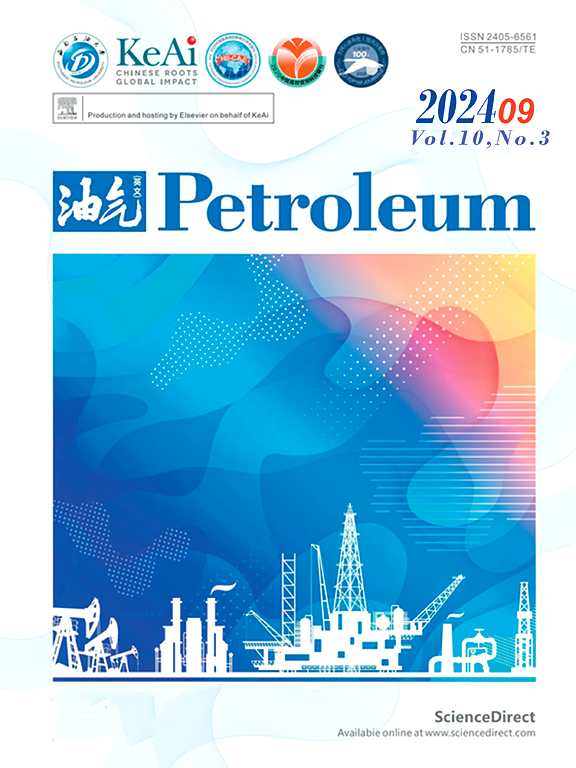Drilling dynamics measurement of drilling motors and its application in recognition of motor operation states through machine learning
IF 4.2
Q2 ENERGY & FUELS
引用次数: 0
Abstract
Drilling motors are widely used in unconventional oil and gas exploration. Due to the increased non-productive time and drilling costs brought about by accidental damage to drilling motors, predictive maintenance for drilling motors is necessary to optimize asset utilization. However, service companies face significant challenges in achieving predictive maintenance: operational data acquisition, automated statistics analysis, and drilling state recognition. This paper presents a miniature vibration recorder, an automatic statistical analysis method, and a layered recognition algorithm to resolve these challenges and improve tool maintenance efficiency. The designed recorder can be installed in the catch of a conventional mud motor to record drilling dynamics over a drilling motor's entire operation cycle. Time-series data from the recorder can be used to automatically generate operation statistics, mitigating the costs incurred by manual data analysis. The layered recognition algorithm then enables the automatic identification of drilling operation states, i.e., surface, downhole non-drilling, downhole sliding, and downhole rotation. The solutions were validated by deploying the recorder in drilling field runs and analyzing recorded data using the associated design software, yielding a functional data collection, automatic data statistical analysis, and operation state recognition accuracy of 95%. Through achieving improved data collection and analysis, the recorder and software introduced in this work can notify motor owners of the detailed operation history of their tools and enable informed preventive maintenance.
钻孔电机的钻孔动态测量及其在通过机器学习识别电机运行状态中的应用
钻井电机在非常规油气勘探中有着广泛的应用。由于钻井电机意外损坏会增加非生产时间和钻井成本,因此有必要对钻井电机进行预测性维护,以优化资产利用率。然而,服务公司在实现预测性维护方面面临着重大挑战:操作数据采集、自动统计分析和钻井状态识别。本文提出了一种微型振动记录仪、一种自动统计分析方法和一种分层识别算法来解决这些问题,提高刀具维护效率。设计的记录仪可以安装在传统泥浆马达的捕捉器中,记录钻井马达整个作业周期的钻井动态。来自记录仪的时间序列数据可用于自动生成操作统计数据,减少手动数据分析带来的成本。然后,分层识别算法能够自动识别钻井作业状态,即地面、井下非钻井、井下滑动和井下旋转。通过将记录仪部署到钻井现场,并使用相关的设计软件分析记录的数据,验证了这些解决方案,产生了功能数据收集,自动数据统计分析,操作状态识别准确率达到95%。通过改进数据收集和分析,本工作中引入的记录仪和软件可以通知电机所有者其工具的详细运行历史,并实现知情的预防性维护。
本文章由计算机程序翻译,如有差异,请以英文原文为准。
求助全文
约1分钟内获得全文
求助全文
来源期刊

Petroleum
Earth and Planetary Sciences-Geology
CiteScore
9.20
自引率
0.00%
发文量
76
审稿时长
124 days
期刊介绍:
Examples of appropriate topical areas that will be considered include the following: 1.comprehensive research on oil and gas reservoir (reservoir geology): -geological basis of oil and gas reservoirs -reservoir geochemistry -reservoir formation mechanism -reservoir identification methods and techniques 2.kinetics of oil and gas basins and analyses of potential oil and gas resources: -fine description factors of hydrocarbon accumulation -mechanism analysis on recovery and dynamic accumulation process -relationship between accumulation factors and the accumulation process -analysis of oil and gas potential resource 3.theories and methods for complex reservoir geophysical prospecting: -geophysical basis of deep geologic structures and background of hydrocarbon occurrence -geophysical prediction of deep and complex reservoirs -physical test analyses and numerical simulations of reservoir rocks -anisotropic medium seismic imaging theory and new technology for multiwave seismic exploration -o theories and methods for reservoir fluid geophysical identification and prediction 4.theories, methods, technology, and design for complex reservoir development: -reservoir percolation theory and application technology -field development theories and methods -theory and technology for enhancing recovery efficiency 5.working liquid for oil and gas wells and reservoir protection technology: -working chemicals and mechanics for oil and gas wells -reservoir protection technology 6.new techniques and technologies for oil and gas drilling and production: -under-balanced drilling/gas drilling -special-track well drilling -cementing and completion of oil and gas wells -engineering safety applications for oil and gas wells -new technology of fracture acidizing
 求助内容:
求助内容: 应助结果提醒方式:
应助结果提醒方式:


